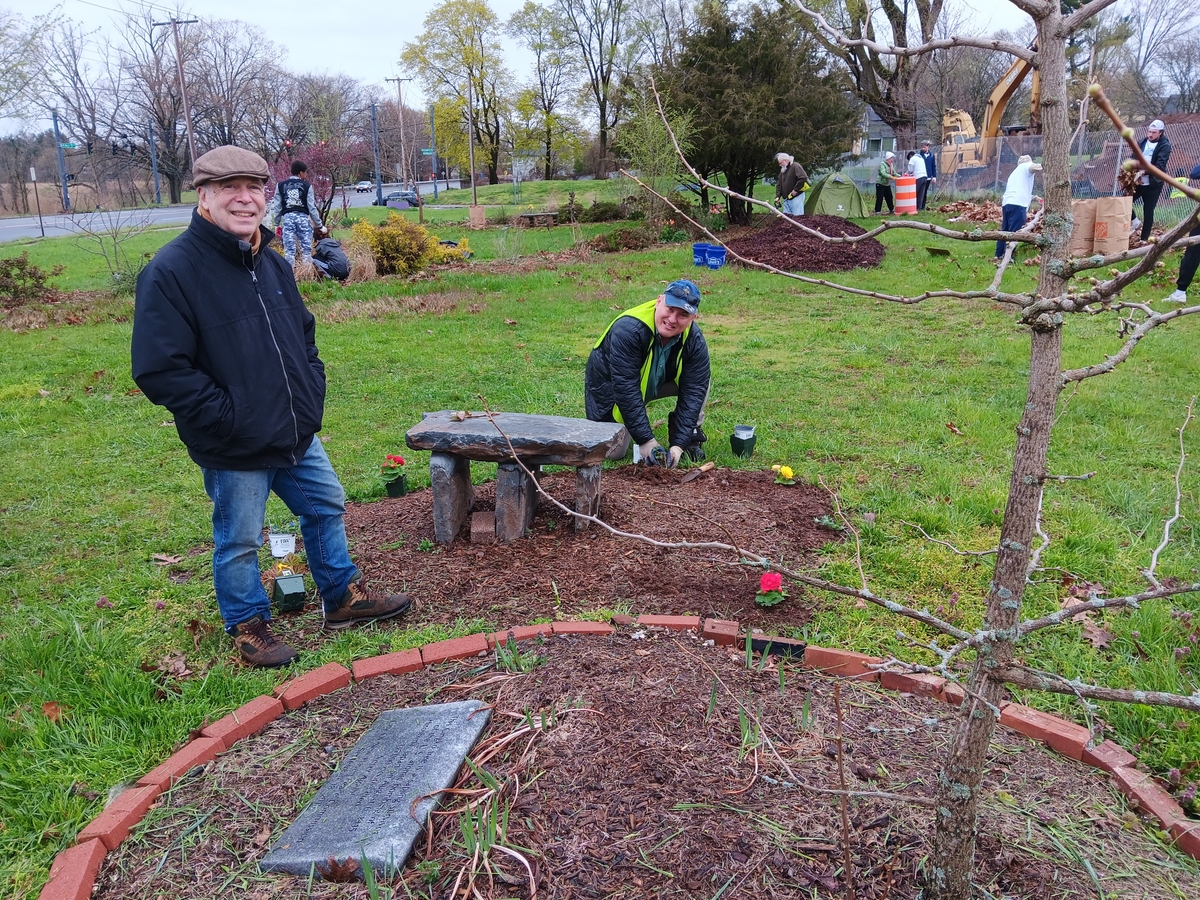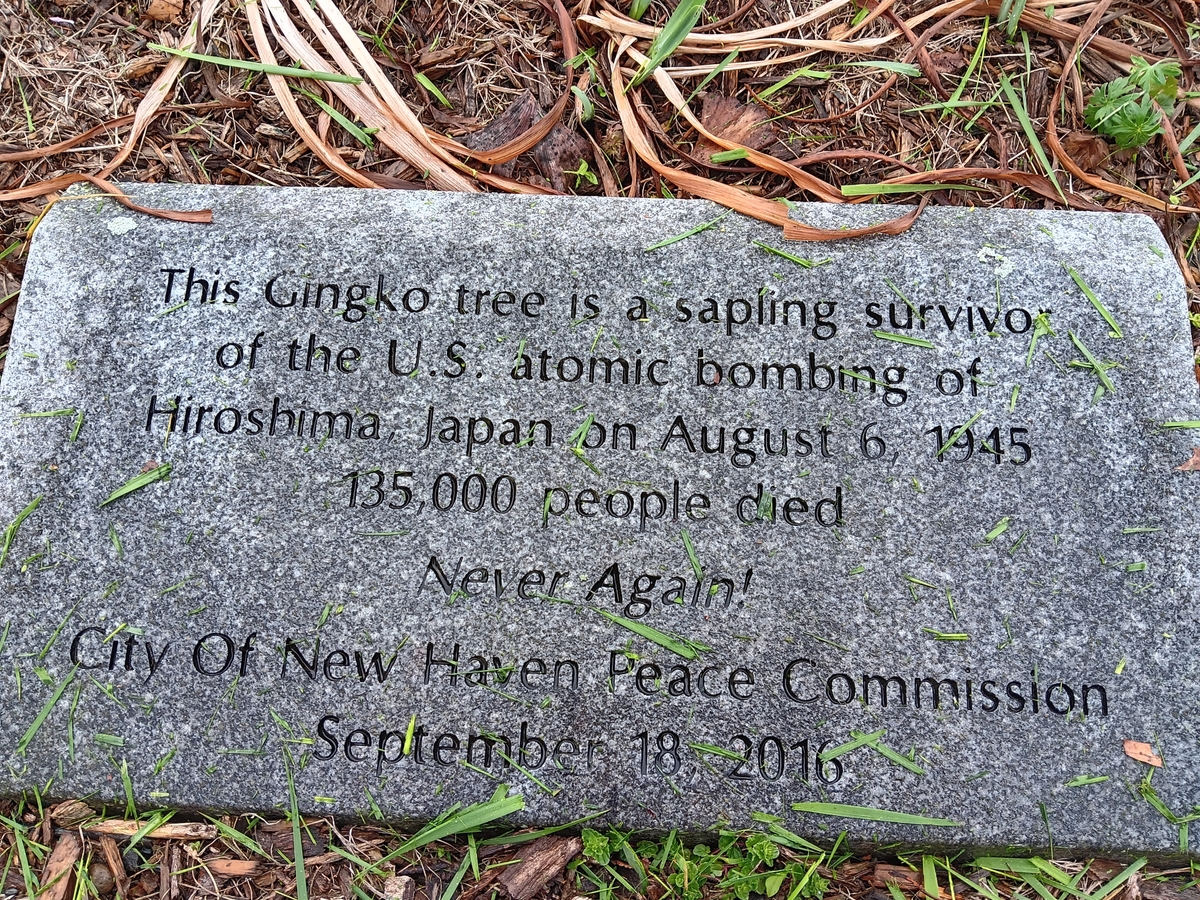
Allan Appel Photo
Daniel Wood, Jeremy Tremblay, Stephany Miller, Paul Bloom, Aaron Goode, and Millie Grenough on Thursday.
City peace commissioners and a crew of freshmen from Albertus Magnus College ventured out to a green patch off of Ella T. Grasso Boulevard with rakes, gloves, bags, and high hopes for adding a little color and joy to the world.
They braved a rainy Thursday morning to tend to the West River Peace Garden.
Established back in 1988 by the City of New Haven Peace Commission and West River residents’ groups, the garden sits on the acre or so of grass fronting the boulevard at Legion Avenue. The greenspace includes a ginkgo tree descended from one of the saplings to survive the atomic bombing of Hiroshima in 1945.
More than three decades after its founding, the garden in effect will become the future spacious front yard of the Curtis Cofield II Estates, the 56-unit low-income townhouse-style campus facing the boulevard and rapidly rising between Legion Avenue and Martin Luther King, Jr. Boulevard.

Aaron Goode planting near the bench by the gingko.
On Thursday, the gardeners were on hand to clean out the beds around the winterberry, coreopsis, and butterfly milkweed, and pop into the newly mulched soil some colorful spring harbingers like morning glories and pansies.
“It’s a marvelous coalescence,” said Paul Bloom, a member of the commission, “that the same [West River] community that came together then” to help create the commission and then to qualify New Haven as an official United Nations Peace Messenger City in 1993 “is also connected” with the new housing development.
“They were concerned about gun violence,” Bloom traveled back in time as he showed this reporter the ginkgo, “and the founders of the peace commission were engaging with the UN initiative to promote a city-wide culture of peace in New Haven, that is, designating it a Peace Messenger City.”
Many of those same neighbors, Bloom added, are part of the West River Self Help Investment Plan (WRSHIP), which is a partner with the New York-based NHP Foundation in the development of the 4.3 acre, $20 million Curtis Cofield Estates project.
Bloom, who is an architect, is leading plans, via the commission’s Peace Garden Advisory Committee, for reconfiguration of the peace garden and park. They include creating pathways from the ginkgo to the central planted area, along with benches and other gathering areas to be used for contemplative moments or just as a park area for the future families to enjoy.
Millie Grenough, another of the commission organizers of the clean-up, and Bloom both spoke about some grander features of the planning for the garden upgrades. They include a more formal entryway to the garden, what Bloom (he’s also the leader of the New Haven Zen Center) described as a Buddhist “gateless gate” — two verticals and a horizontal to usher people in to the garden.
If city parks’ or other funds can be accessed, a more formal, defined entryway could be achieved, and a grander one. They had in mind a kind of bridge (similar to the one connecting Barnard Environment School across the boulevard) enabling people to cross over the always busy boulevard directly from West River Park.
However, for student volunteers like Albertus freshman Jeremy Tremblay, the perspective was less long, historical, or architectural, and more of the present moment. A native of Montreal, he has a car at school enabling him to drive around New Haven and he has noticed a lot, he reported, including a lot of trash.
“With all the struggles going on in New Haven today,” he said as he raked and bagged a long winter’s worth of brown, wet leaves, “you see so much trash and there’s so much potential, it’s good to pick up.”

Paul Bloom by ginkgo tree.
A long-time member of the commission, Aaron Goode, said that the peace garden sits technically not on official New Haven city park property, but a kind of orphaned or “unassigned” parcel.
Translation: Members of the Peace Commission and other volunteers they are able to corral have over the years carried the responsibility of maintaining the peace garden, the ginkgo, and its explanatory slab. They also care for the surrounding acres of grass and other plantings.
“It’s a huge challenge making this park accessible,” he added. At the center of that challenge is the highly trafficked location cheek by jowl with one of the fastest, most accident-prone stretches of roadway in the city. “But it’s also an opportunity” with the new housing development and its families now entering the picture in the coming year.
As the vehicles rolled by, he added, “You can’t have a contemplative moment here, if you can’t enter except by driving a truck over a curb. Maybe the [more tended, visible] expression of peace in the garden will remind people to slow down.”
That may come to pass especially next year when families move in, but the experience of being in the garden and cleaning up, with the backhoes churning and the new housing rising behind him, had already worked a little magic for Jeremy Tremblay.
In the culminating activity of the clean-up, Grenough gathered all the participants in a circle near the ginkgo tree, and solicited their main take-away from the morning’s work. “It’s the joy that it brought me,” said Tremblay. “Today I am grateful.”

For those interested in the work of the commission and advancing plans for the peace garden, the site is PeaceCommission.net and members meet by Zoom on the third Thursday of each month between 7:30 and 9:00 p.m.


Wonderful that the volunteers are sprucing up the peace garden. It will be very important to the nearby development residents to enjoy.
Having a
“ They had in mind a kind of bridge (similar to the one connecting Barnard Environment School across the boulevard) enabling people to cross over the always busy boulevard directly from West River Park.”!”
is a great idea! A bridge to allow residents and neighbors to cross the Boulevard safely would benefit so many in the West River and Hill neighborhoods.
I hope the city can have this made into an official pocket park, to protect it for the good of the people of the city.
And I hope traffic calming measures to protect pedestrians and bike riders can be put on Frontage Rd and Legion Ave so more people can safely visit the parks and each other across the Highway To Nowhere.